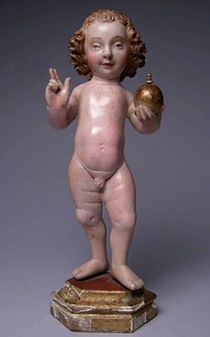Location Paris, France Witness Unpublished | Date 1500s Holy See approval None granted | |
 | ||
Shrine Louvre MuseumDepartment of Sculptures Similar Santo Bambino of Aracoeli, Infant Jesus of Prague, Santo Niño de Cebú | ||
The Infant Jesus of Mechelen (French: l'Enfant Jésus de Malines) is an unadorned Roman Catholic 16th-century wooden image depicting the Child Jesus holding a globus cruciger and imparting a priestly Catholic blessing.
Contents
Among Santo collectors, the image is often referred to the "fraternal twin" of the Santo Niño de Cebu, with which it shares crucial similarities on posture, gesture, facial expression, and measurement. In September 2009, the image was privately acquired and now housed in the Louvre Museum under security glass. It is displayed naked without any regalia, accessories or vestments formerly associated with other Child Jesus icons.
Description
The image depicts Jesus Christ in his infancy stage. The polychrome materials and characteristics are distinctly from Mechelen, a former part of the Southern Netherlands dating from the early 1500s. The child image alone is made of walnut, carved in a single block piece of wood. The present image is untouched, devoid of any professional restoration work and comprises the following details:
Evidence of European colonial characteristics are present on the statue, such as the gilding of the hair using gold leaf while lead paint and oily potassium is used to the skin, similar to the Encarnacion style of sculpting and painting. Further microscopic examination show research that the image was carved in Mechelen, but was probably painted in Brussels then taken to be distributed in the colonized territories of Spain.
Comparison with the Niño de Cebú image
Both the Mechelen statues and the Santo Niño de Cebu are approximately the same height at approximately 30 cm (12 inches) tall, while having similar characteristics such as the standing pose, naked body, hand blessing gesture and golden globes. Assuming that the camera shots are frontally accurate, the faces are almost exactly similar to one another with the following exceptions:
Acquisition by the Louvre Museum
The history of acquisition and ownership is unknown and unpublished by the Louvre or Parisian authorities. The image was acquired from a private collector in September 2009 by the Louvre Endowment Fund. It underwent polychrome study, xylology inspection, and radiography to confirm its age and colonial style of authenticity. The image is housed in the Louvre Museum under the Department of Sculptures.
Several pious American Traditionalist Catholics from Texas and New York petitioned the Louvre Endowment fund to purchase and release the custody of the image in 2012 but this petition was not granted. The French magazine La Tribune de l'art featured the image on 16 June 2010 as part of recent Medieval acquisitions by the Louvre Museum.
